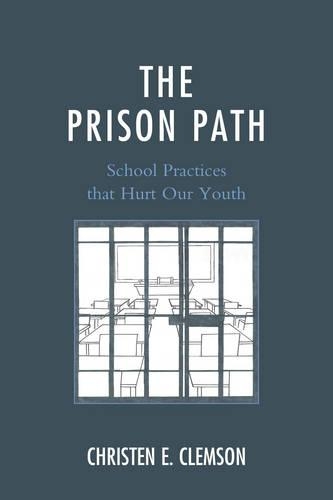
The Prison Path: School Practices that Hurt Our Youth
(Hardback)
Available Formats
Publishing Details
The Prison Path: School Practices that Hurt Our Youth
By (Author) Christen E. Clemson
Bloomsbury Publishing PLC
Rowman & Littlefield Publishers
16th March 2015
United States
Classifications
Professional and Scholarly
Non Fiction
Educational administration and organization
371.2
Physical Properties
Hardback
168
Width 152mm, Height 229mm
Description
The Prison Path: School Practices that Hurt Our Youth takes a unique and unapologetic look into the practices, social norms, construction, and policies within our schools that mirror prisons. From the physical building to the labeling and placement of special education students, schools are reflecting correctional institutions. Beyond the mundane and into the world of social cliques, discipline policies, uniforms, and ethics, this book highlights how similarities between schools and prisons create a hidden and dangerous environment for at-risk students. While many schools and teachers are doing the best they can while facing budget shortfalls, it is the inherent policies, procedures, and normalities that are thought of as being part of the school experience, that may be the most hazardous for at-risk students. Therefore, this book highlights these occurrences and juxtaposes them with similar situations within prisons, providing an eye-opening and daunting look at prisons and schools. This book will cause teachers and those within education to question the practices, policies, and norms that we consider part of the typical school experience. Some additional key features of this book include: Chapter by chapter examination of the similarities in prisons and school Detailed look at the process of special education labeling and its detrimental impact on students Examination of the role of social cliques and gangs in institutions A unique look at the school-to-prison pipeline In-depth questions to ask oneself about to improve schools Dangers of inviting school resources officers into schools and cutting guidance services Real-life scenarios
Reviews
The Prison Path: School Practices that Hurt Our Youth addresses ethical and moral issues associated with incarceration and schooling drawing an interesting and challenging parallel between both social processes. Issues related to loss of freedom, ethics in unequal power relationships, and the importance of learning for ones self image and potential for a full life are foundational to the text. This is an unusual book with overtones of Deschooling Society by Illich (1969) in the way it integrates ethics and learning. This book will be of great interest to readers challenged by modern societys approach to learning, rehabilitation, recidivism, institutional learning, and the moral life of the marginalized. Christen Clemson challenges preconceived images of prison and school life aims to have readers reflect and rethink their approaches to the morality of institutional life. -- Charles Burford, professor of educational leadership, Australian Catholic University
Clemsons education, knowledge, and insight into the school to prison pipeline has been a passion of hers for over four years. Her chapter, Space, Place, and the Power of a Box is extremely timely in todays society. The correlations she has made between school and prison spaces are extremely powerful and gut wrenching. This book is an eye opening look forward. If we as educators do not begin looking closer at zero tolerance policies and how we are impacting children at such a young age and at an alarming rate we as educators and educational leaders may have a catastrophe in the making on our hands! Clemson has laid the groundwork for a movement toward better understanding and increased awareness. -- Jeannette L. Brelsford, PhD
A succinct examination of the long standing history of American education in preparing children first for citizenship and secondly as prisoners when they question the authoritarianism of American schooling. With brilliant and insightful analysis as to the current direction of American education this book a must read for anyone involved in the process. -- Joy Meness
Author Bio
Christen E. Clemson grew up in a small farming community in Northeast Ohio, where she was involved in her community and excelled in athletics. Athletics then led her to The Pennsylvania State University, where she competed for five years and went on to earn her bachelors in Secondary in Education, a masters in Educational Leadership, and soon she will be finishing her Doctorate in Educational Leadership.
